India has embarked upon a digital health journey with the launch of the Ayushman Bharat Digital Mission (ABDM) - the flagship scheme of India, launched on September 27 based on the recommendations of the National Health Policy 2017. The aim with which ABDM was launched is to develop the backbone necessary to support the integrated digital health infrastructure of the country. Under the mission, citizens will be able to create their Ayushman Bharat health account numbers, to which their digital health records can be linked.
As a cutting-edge initiative that will redefine India’s future of public health and development, the implementation of the Ayushman Bharat Digital Mission (ABDM) marks an important step in the global push for Universal Health Coverage (UHC).
ABDM has been designed to provide digital health IDs for all Indian citizens to help hospitals, insurance firms, and citizens access health records electronically and therefore serves to bridge the information gap amongst different stakeholders of the healthcare ecosystem through the creation of digital highways.
The Current State of Healthcare in India
While technology has been deployed in the healthcare industry for a while, the benefits have been localized and fragmented so far. The citizens are neither able to seamlessly access their health records nor store them conveniently. This has largely been a result of the absence of an integrated system where the healthcare service providers do not have an aggregated and complete view of the data for providing efficient health services to the citizen.
The need of the hour is therefore to build an integrated digital health infrastructure that will be more robust, secure, and inclusive in nature.
The Birth of Ayushman Bharat Digital Mission
The Ayushman Bharat Digital Mission (being implemented and monitored by the National Health Authority) project will now connect the digital health solutions of hospitals across the country with each other which will serve to empower the doctors to access the full medical history of their patients, all at one place – but of course, with consent. The health data of the beneficiaries stay secure, and no one can access them without the consent of the patient. The patient has full control over his data – he/she decides what he/she wants to share, and with whom. The ultimate mission of this humongous project is to bring every stakeholder related to the healthcare sector, on one single platform.
ABDM will enable the movement of health information from one entity to another irrespective of whether the two are connected to each other or not. ABDM is a win-win situation for all stakeholders in the healthcare ecosystem with the biggest beneficiary being the patient.
ABDM, through its integrated services, gives doctors & other healthcare providers an information backbone that makes it easier to track, access, and update patient data, eliminating the duplication of effort and reducing the chances of error in the data collection process. This not only makes patient care more efficient but also gives providers access to detailed information. The result is improved patient care and reduced healthcare costs.
Under this Mission, patients can opt-in to create a Health ID allowing them to share their medical records with healthcare providers including doctor’s appointment, diagnosis of an ailment, line of treatment, hospitalization for any treatment, and drugs taken with an aim to provide high-quality healthcare for all.
Digitizing medical records and making them interoperable in one coordinated system would be a significant step forward for patient care by simplifying the process of coordinating care between providers, reducing wait times, standardizing treatment, and ultimately lowering costs.
The objectives of ABDM
The ABDM intends to create interoperability between different digital health systems. Therefore, there is no requirement for storing all the digital health records in one place or in one system. It is planned that all the digital health records which have been and shall be created while providing healthcare shall continue to be stored in the same digital system that the respective healthcare provider (hospital, doctor, etc.) is using currently.
ABDM emphasizes interoperability and a single source of truth while making healthcare services accessible to every citizen of India.
Ayushman Bharat Digital Mission will connect the digital health solutions of hospitals across the country with each other. Some of the objectives of this mission can be summarised below:
-
To establish the national and regional registries that can create a single source of truth with respect to identifying Patients, healthcare professionals, and healthcare facilities
-
Establishing appropriate governance to ensure effective stewardship of the program.
-
Developing a state-of-the-art digital health infrastructure for managing digital health data and its seamless exchange across health systems.
-
Fostering government-private partnerships for developing end-to-end health solutions
-
Enforce the adoption of open health information standards that is easily accessible across patients, healthcare professionals, and service providers with appropriate patient consent.
Only the data collected through registries such as the Health ID registry, Healthcare Professional Registry, and Healthcare Facility Registry is stored centrally. It is necessary for these datasets to be stored centrally because they are essential in providing interoperability, trust, identification, and a single source of truth across different digital health systems.
Therefore, summarising, the pillars on which ABDM has been built are as follows:

Components of ABDM
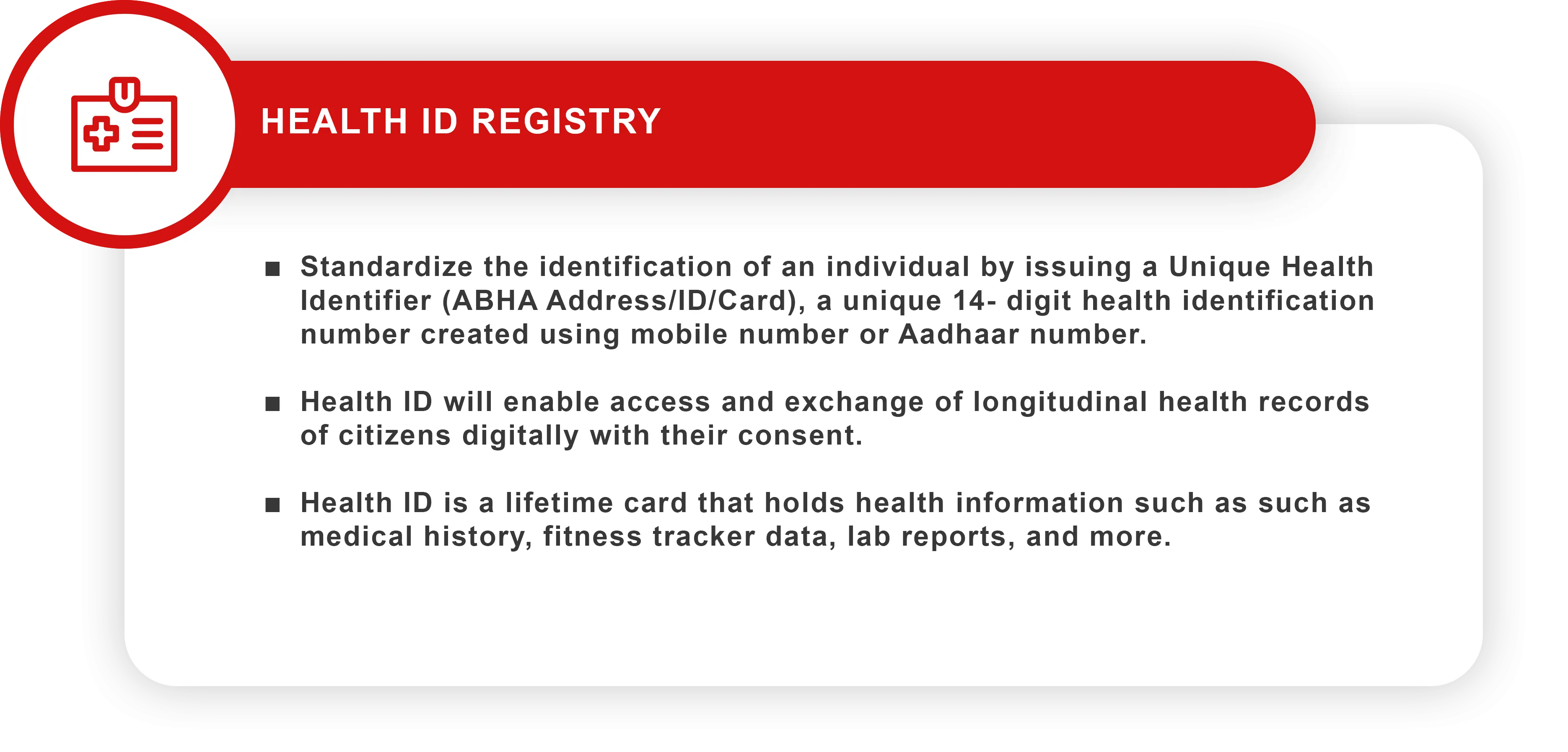
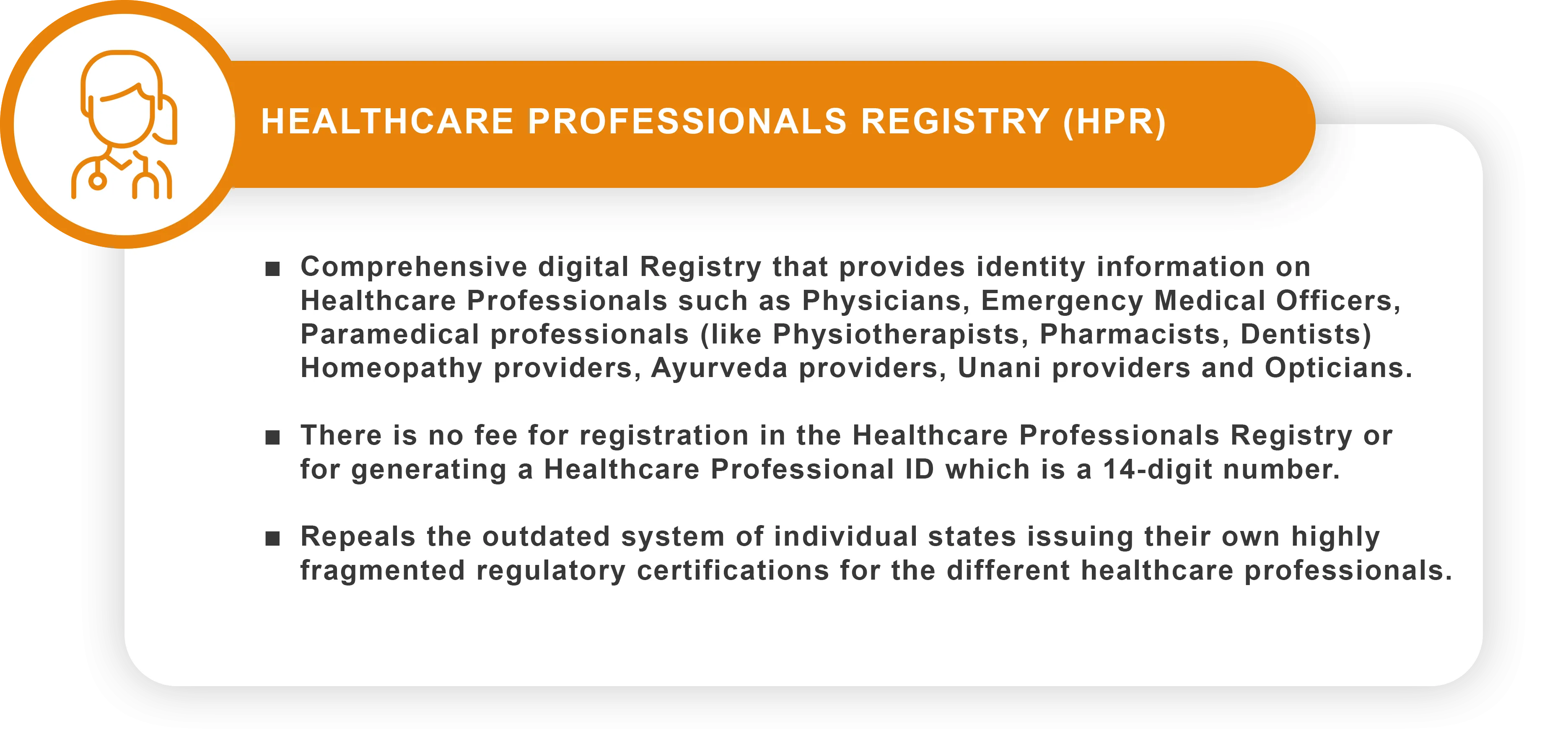
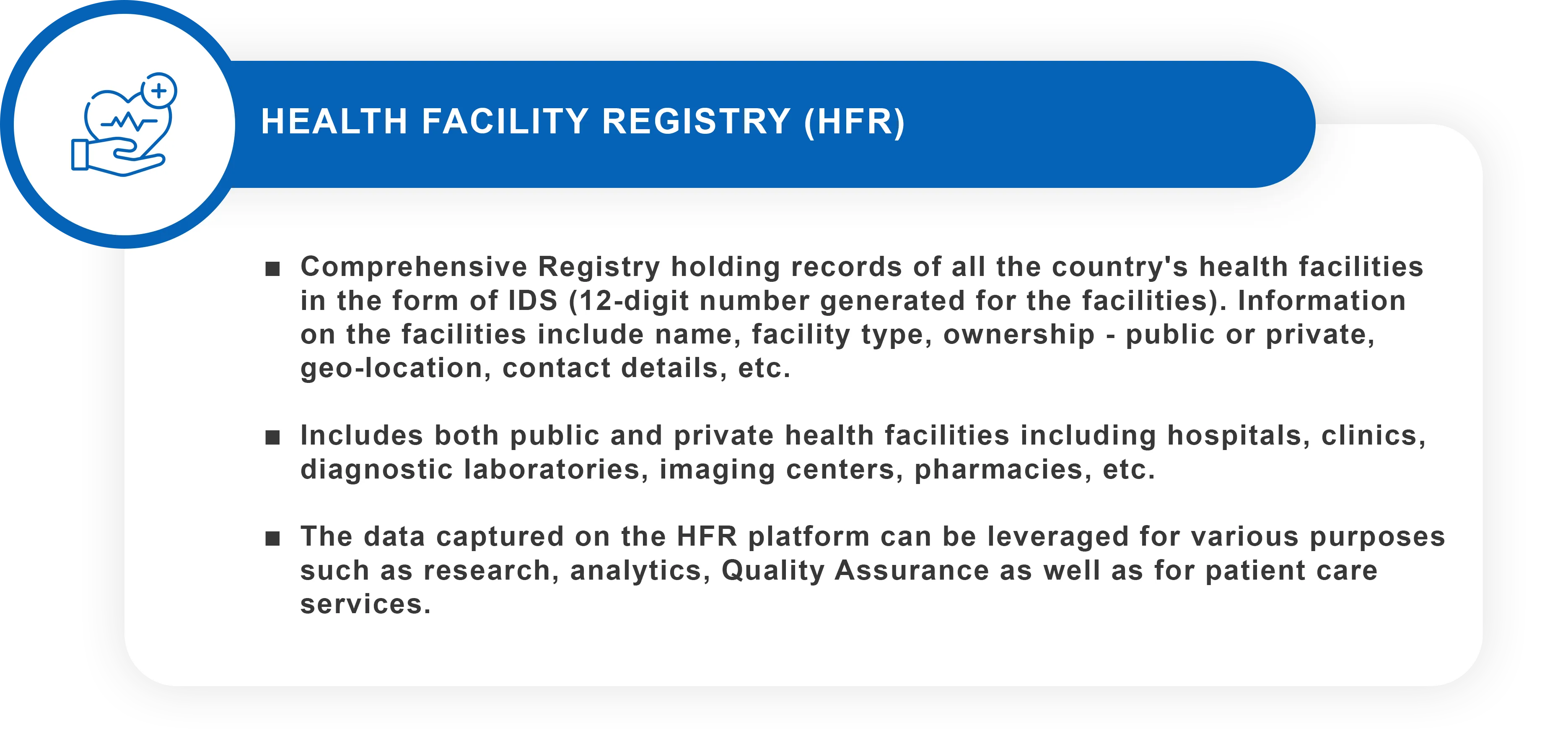
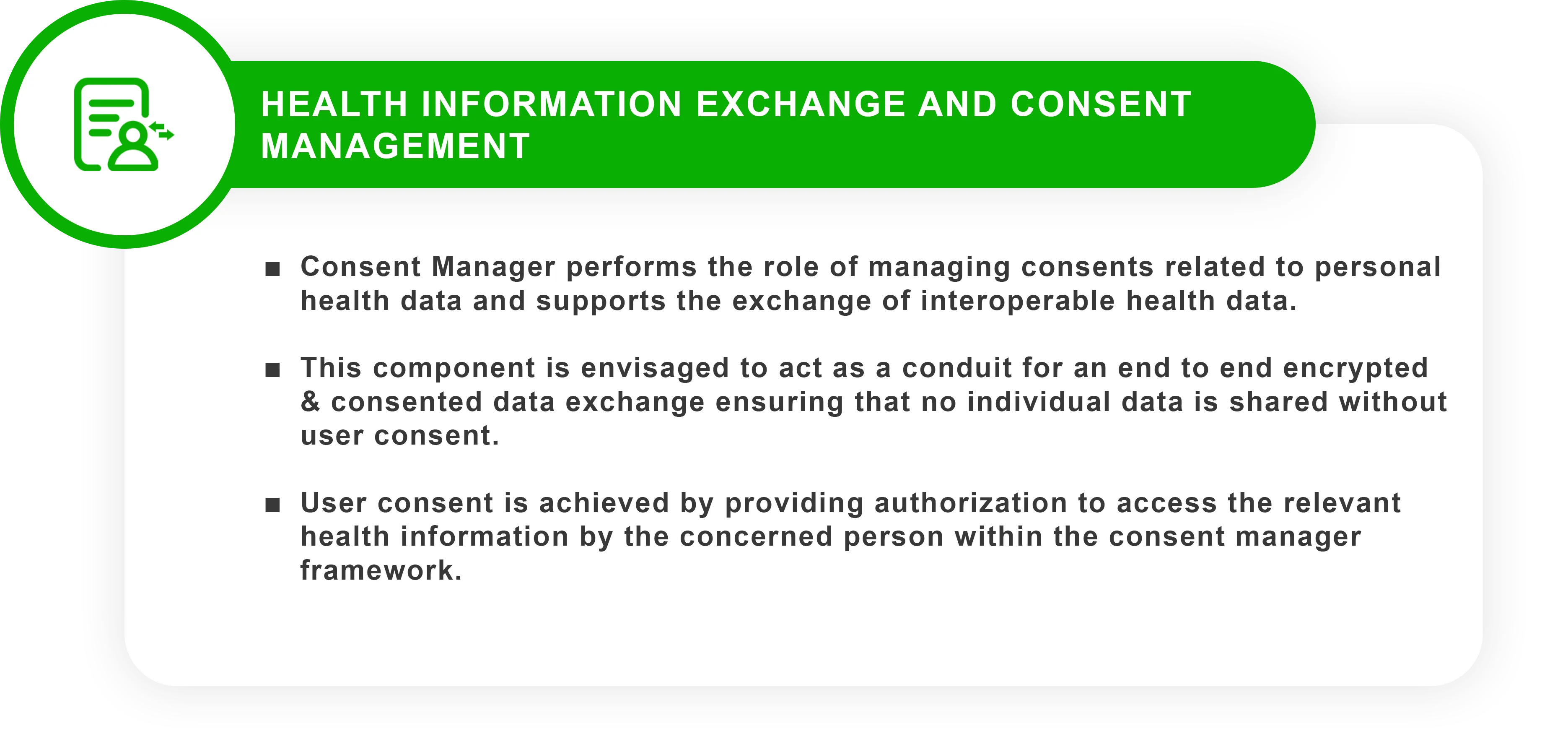


ABDM Architecture
ABDM comprises three categories of building blocks as shown below:
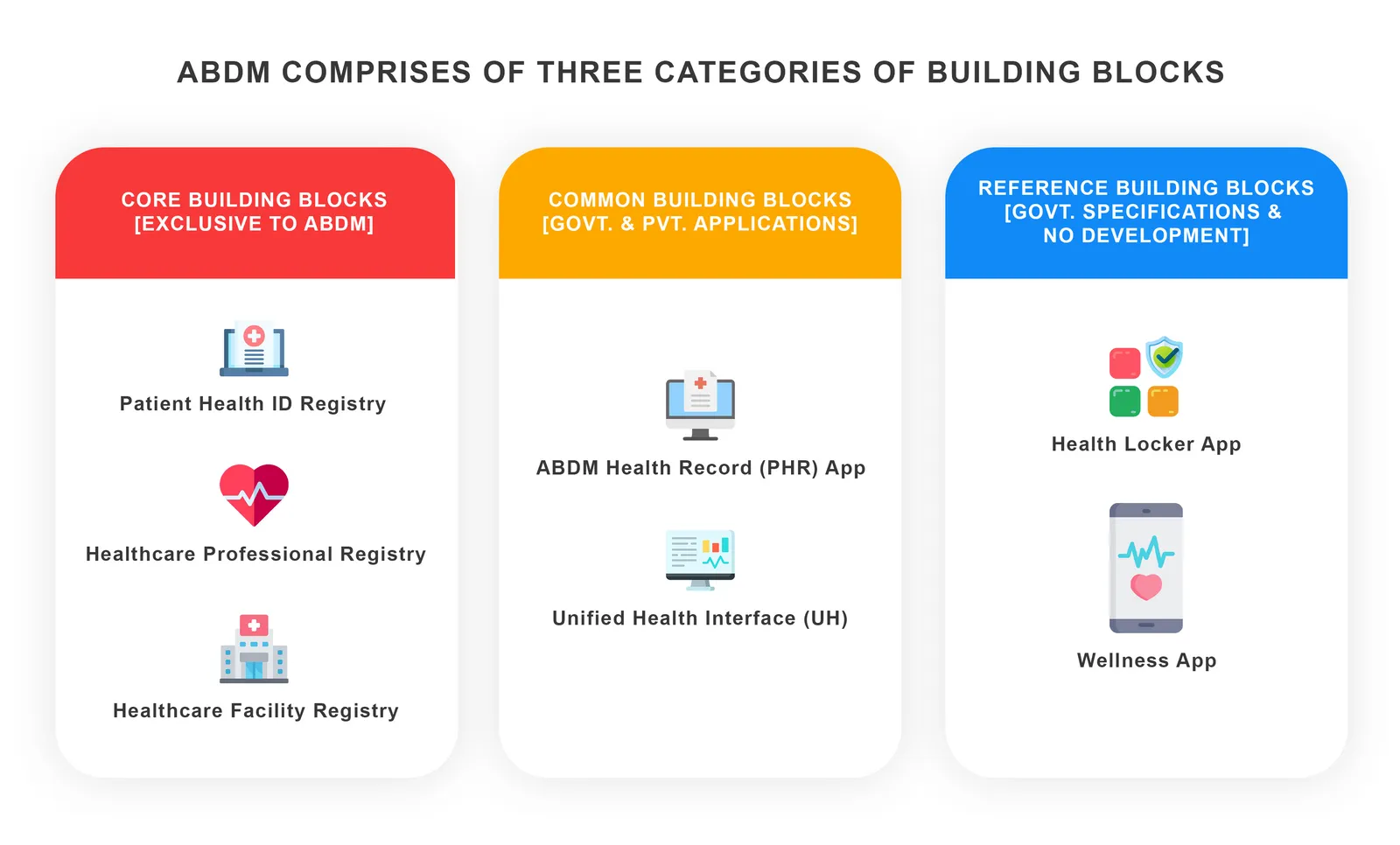 The Core Building Blocks include Registries that are meant solely for establishing identity and no centralized health records are maintained here.
The Core Building Blocks include Registries that are meant solely for establishing identity and no centralized health records are maintained here.
Common Building Blocks are comprised of both Govt and Private applications such as PHR App.
Reference Building Blocks comprises guidelines/Specifications for applications such as wellness apps, or Health locker with no development activities.
ABDM Architecture
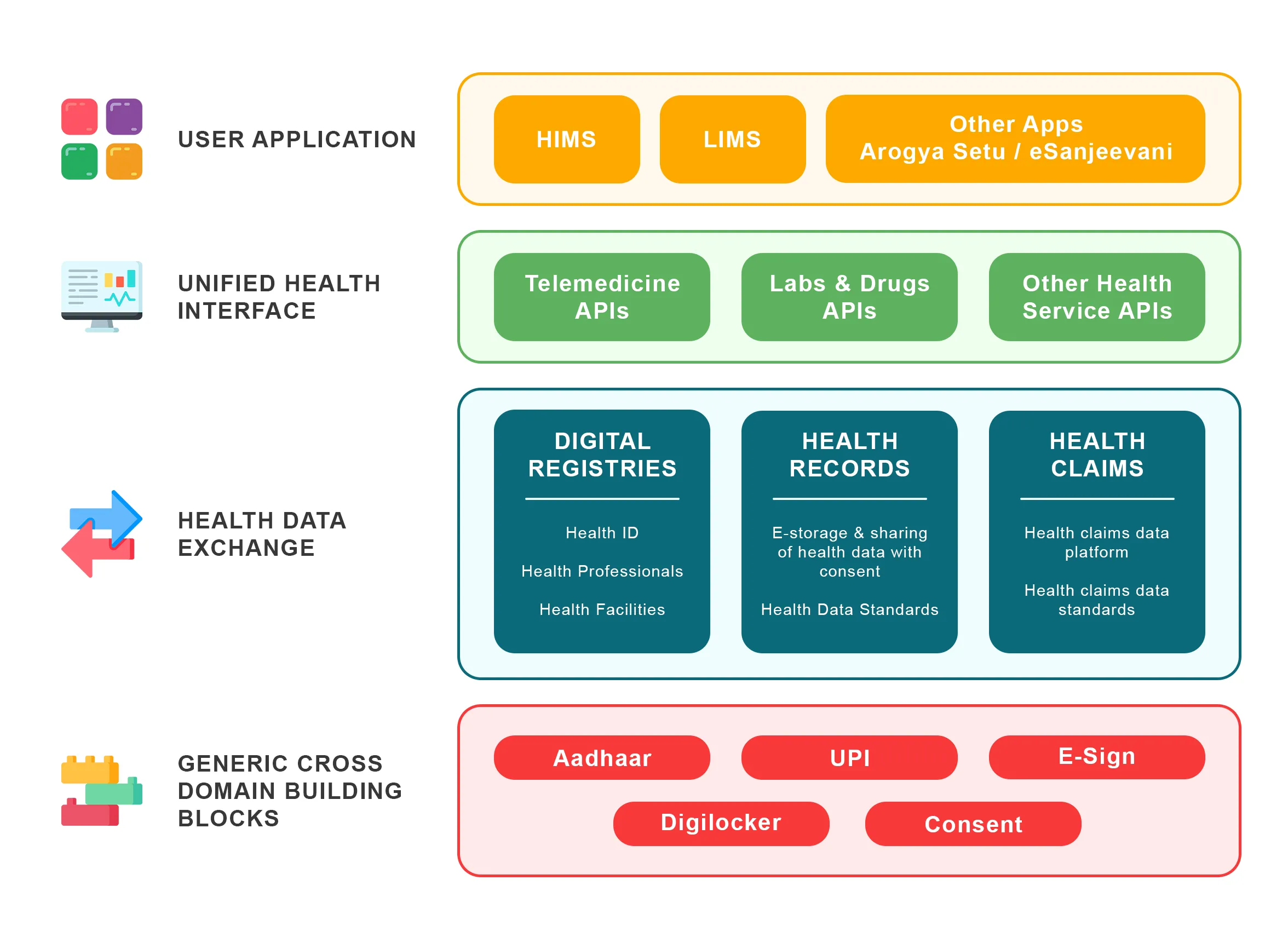 As evident from the figure above ABDM has a four-layered architecture.
As evident from the figure above ABDM has a four-layered architecture.
Layer 1 (from bottom)
The ABDM architecture leverages the cross-domain public building blocks in the form of Aadhaar (which represents identity), UPI (represents payments), e-sign (electronic signature service), Digilocker (storage of patient records), Consent artifact (represents authorizations given by patients) as the basic foundational layer.
Layer 2
The second layer from the bottom is the Domain Specific layer that comprises the Digital Registries, Health Records, and Claims platform. The Digital Registries enable the identification of Patients/Professionals/Facilities by means of unique IDs. The Health records serve to store and exchange health data in standard format with patient consent. This layer will ensure streamlining of the health data flow and acts as the basic infrastructure which ensures interoperability in the system.
Layer 3
The third layer on top of the Domain-specific layer is the Unified Health Interface (UHI) layer which comprises primarily of the open APIs that enable real-time data exchange and can include health services such as:
- Booking OPD appointments at hospitals/clinics
- Booking Tele-Consultation
- Discovering Bed availability/ lab and diagnostic services
- Access health records of patients with their digital consent
- Share patient health information with their health service providers and receive prescriptions, lab reports and doctor notes digitally on their devices.
Layer 4
The layer that sits on top of the UHI layer consists of the user-facing applications that can include patient-facing applications such as Arogya setu, as well as provider-facing applications such as eSanjeevani, HIMS, and LIMS.
Information flow between the entities on the ABDM platform
The entities that generate the health record of a patient such as Doctors treating a patient or a lab generating a lab report are categorized as Health Information Providers (HIP).
The entities that request access to the health records such as Doctors who wish to see the medical history before making an informed decision, or citizens who wish to view their medical records, etc. are categorized as Health Information Users (HIU).
The Information is exchanged between the above two categories via the Health information Exchange module of the ABDM architecture. ABDM platform acts as a gateway and ensures that health data is shared with HIU by the HIP only when the owner of the data gives consent.
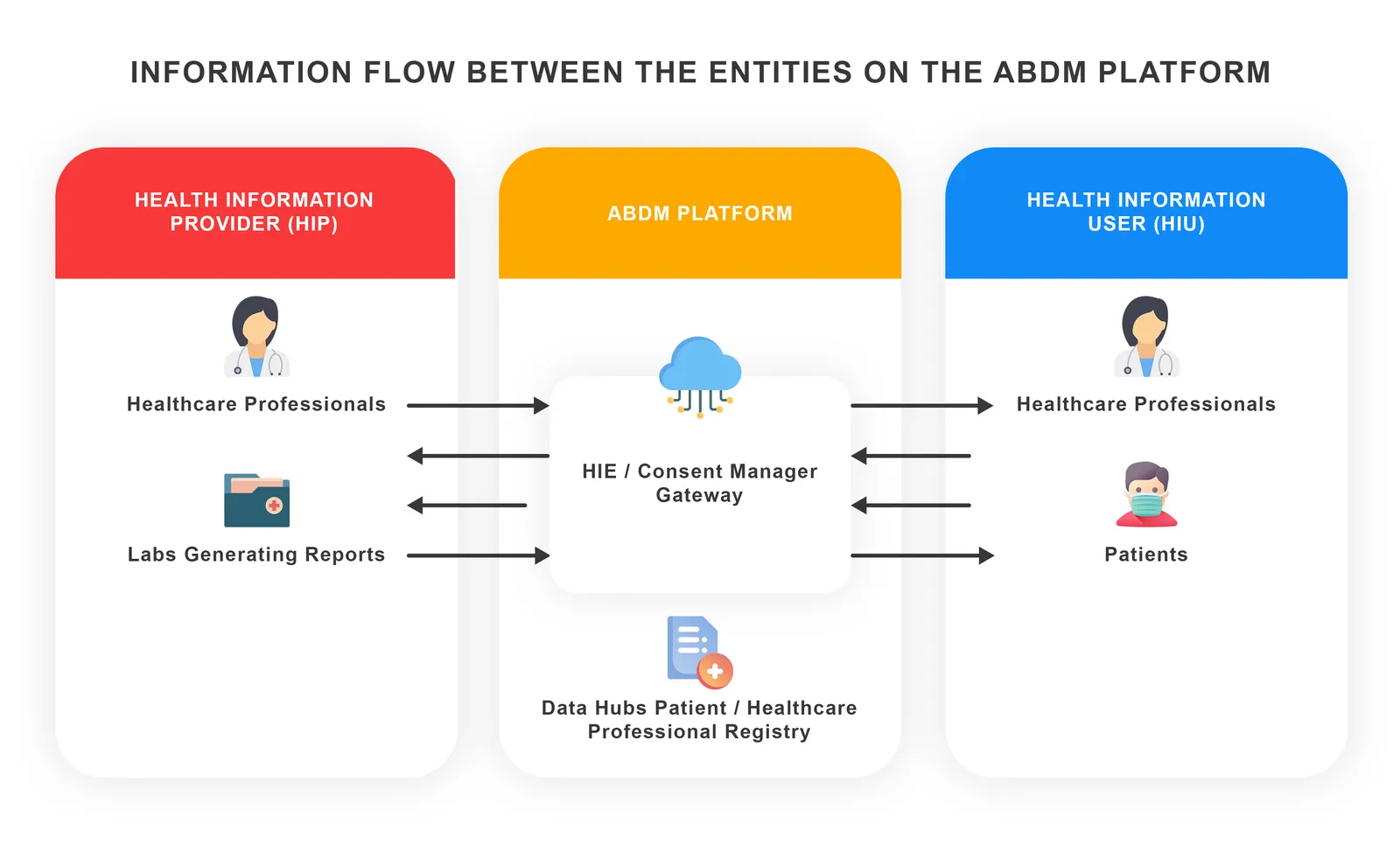
ABDM Sandbox
The ABDM sandbox has been created as part of the mission and acts as a framework for technology and product testing that will help organizations intending to be a part of the national digital health ecosystem and efficiently link with the building blocks of the Ayushman Bharat Digital Mission.
ABDM Sandbox is an experimental digital space that is detached or separated from the actual digital health ecosystem and is created for testing integration processes before the digital health product is made live for actual use.
The technologies or products can be tested in a contained environment in compliance with ABDM standards and be able to judge the consumer and market reactions to the same. Because there are boundary conditions – the risk is minimized and the emphasis is on feedback, learning, and compliance with defined standards required to become a part of ABDM. The environment will allow for both alpha as well as beta testing of the products.
Any entity can register on the ABDM Sandbox by following a step-by-step process of integrating and validating their software systems by using the ABDM APIs. So far, about 745 entities have registered on the ABDM Sandbox.
Some of the benefits of using the ABDM Sandbox are as follows:
- Obtain first-hand empirical evidence of how a new healthcare technology along with ABDM building blocks might work, which helps to appropriately integrate such new technologies with their implementation/business plans.
- Users of the sandbox can test the product’s viability without the need for a larger and more expensive roll-out. If any concerns arise, during the sandbox period, appropriate modifications can be made before the product is launched in the broader market.
- Sandbox will help developers and the technical community to get a first-hand feel of the specifications, tools, technologies, and building blocks of ABDM. It will provide an opportunity for the community to test their ideas and concepts and allow experimentation.
Some of the Risks and Limitations of the ABDM Sandbox are as follows:
- Post-sandbox testing, one may still require necessary approvals before the product/services/technology can be permitted for wider application.
- There is potential for some legal issues coming up, such as those relating to consumer losses in case of failed experimentation.
With the current technological explosion, it’s time for India to embrace the digitization of the healthcare industry that ensures accessibility and transparency in the health ecosystem. It is imperative that the ABDM movement moves forward with its mission to enable access and exchange of longitudinal health records of citizens with their consent.
ABDM envisions a healthcare ecosystem focused on digitizing, supporting, and strengthening the digital health ecosystem by creating an interoperable digital platform that unifies diverse stakeholders such as patients, providers, pharmacies, labs, and health tech startups. This will lead to the creation of a state-of-the-art network of digital health solutions. In addition to strengthening the digital health ecosystem, ABDM also emphasizes the security, privacy, and confidentiality of personal health information.
However, the success of ABDM will depend on the ability to onboard health providers to adopt digital health solutions and standards to build a digital health ecosystem.
The digital health solutions propelled by ABDM can revolutionize how citizens can achieve higher health standards and access services to promote their health and wellbeing.